iPad 4 (Late 2012) Review
by Anand Lal Shimpi on December 6, 2012 4:40 PM ESTGPU Performance
The 4th generation iPad integrates a quad-core PowerVR SGX 554 (MP4). The 554MP4 doubles USSE2 count over the previous generation PowerVR SGX 543MP4 used in the iPad 3, while keeping ROP and TMU counts the same. The result is a pure doubling of peak theoretical shader performance:
| Mobile SoC GPU Comparison | |||||||||||
| PowerVR SGX 543 | PowerVR SGX 543MP2 | PowerVR SGX 543MP3 | PowerVR SGX 543MP4 | PowerVR SGX 554 | PowerVR SGX 554MP2 | PowerVR SGX 554MP4 | |||||
| Used In | - | iPad 2/mini | iPhone 5 | iPad 3 | - | - | iPad 4 | ||||
| SIMD Name | USSE2 | USSE2 | USSE2 | USSE2 | USSE2 | USSE2 | USSE2 | ||||
| # of SIMDs | 4 | 8 | 12 | 16 | 8 | 16 | 32 | ||||
| MADs per SIMD | 4 | 4 | 4 | 4 | 4 | 4 | 4 | ||||
| Total MADs | 16 | 32 | 48 | 64 | 32 | 64 | 128 | ||||
| GFLOPS @ 300MHz | 9.6 GFLOPS | 19.2 GFLOPS | 28.8 GFLOPS | 38.4 GFLOPS | 19.2 GFLOPS | 38.4 GFLOPS | 76.8 GFLOPS | ||||
The theoretical numbers validate Apple's "2x faster GPU" claims, but as always we'll turn to Kishonti's GLBenchmark to see how achievable that performance increase is.
We'll start out with the raw theoretical numbers beginning with fill rate:
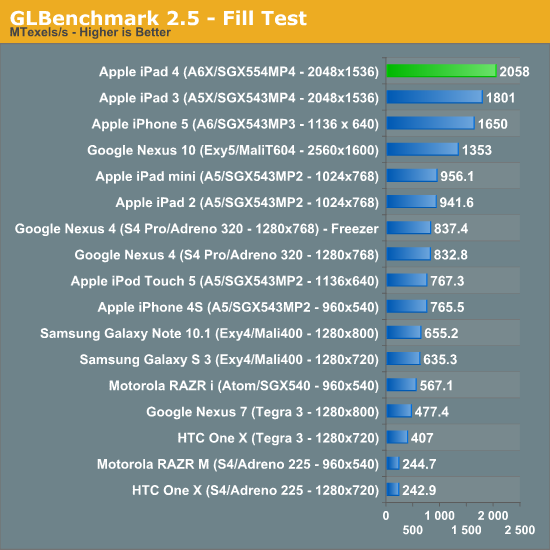
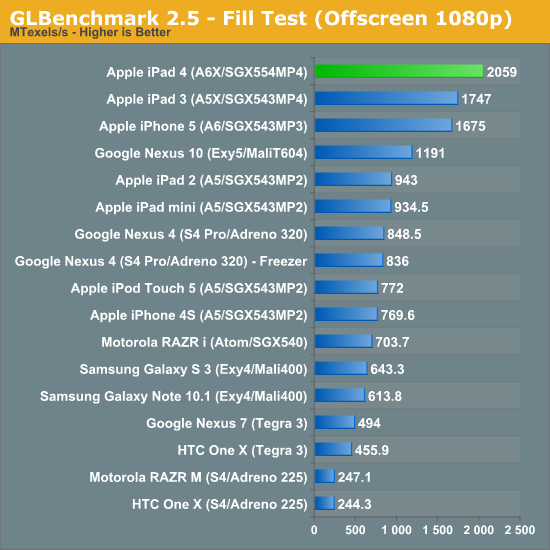
The peak fill rate test shows a ~16% increase in performance over the previous generation 543MP4. Since there's no increase in number of TMUs we're seeing the results of a higher clocked GPU in the iPad 4's A6X.
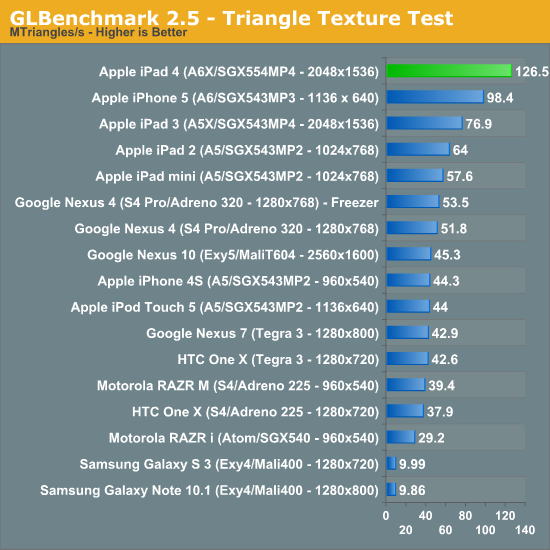
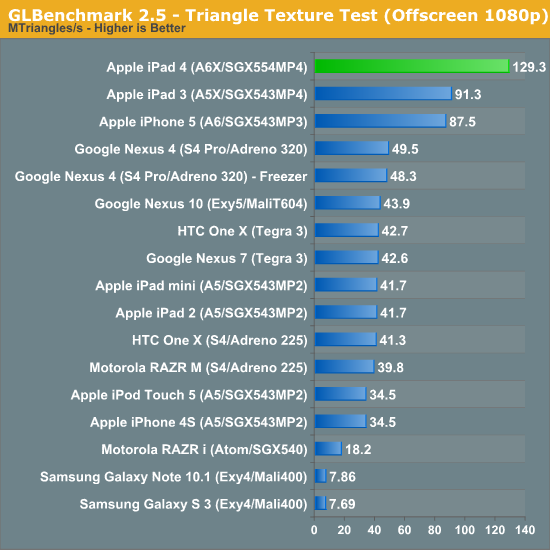
There's a pretty hefty improvement in triangle throughput - we're seeing more than a 60% gain compared to the iPad 3.
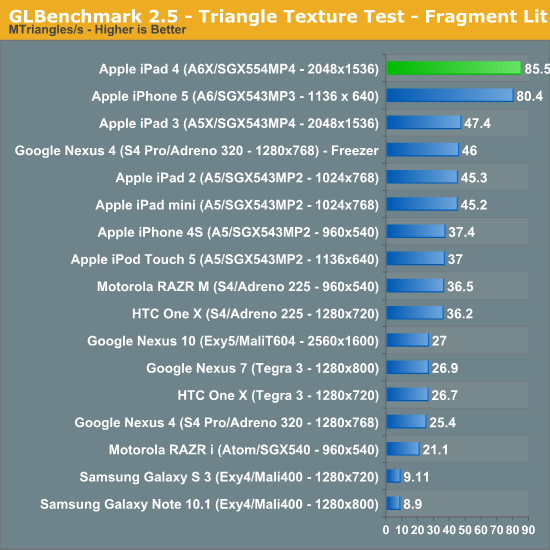
At native resolution the fragment lit triangle texture test shows a big gain over the iPad 3 (~80%).
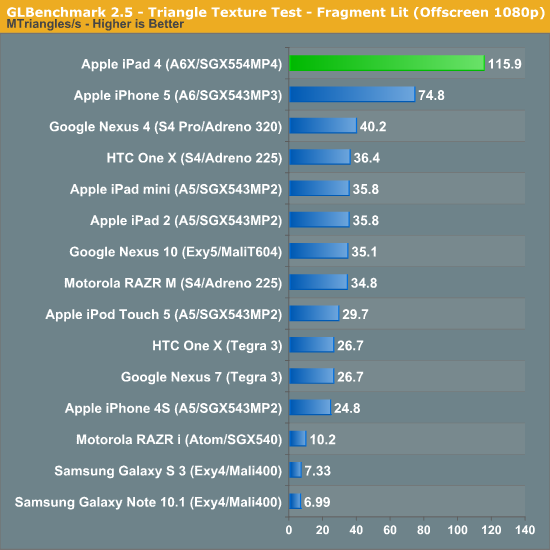
In both of the final triangle throughput tests the iPad 4 manages a 40 - 45% increase in performance over the iPad 3:
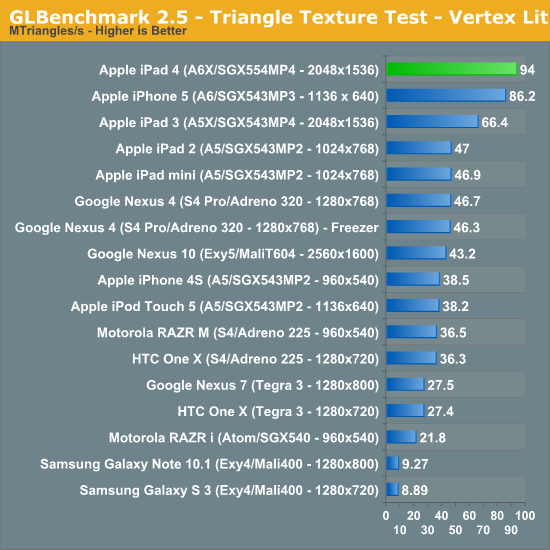

With the synthetics out of the way, we can look at simulated game performance using the Egypt HD and Egypt Classic benchmarks. Remember the on-screen tests are run at native resolution with v-sync enabled, while the offscreen tests are run at 1080p with v-sync disabled for an architectural apples-to-apples comparison.
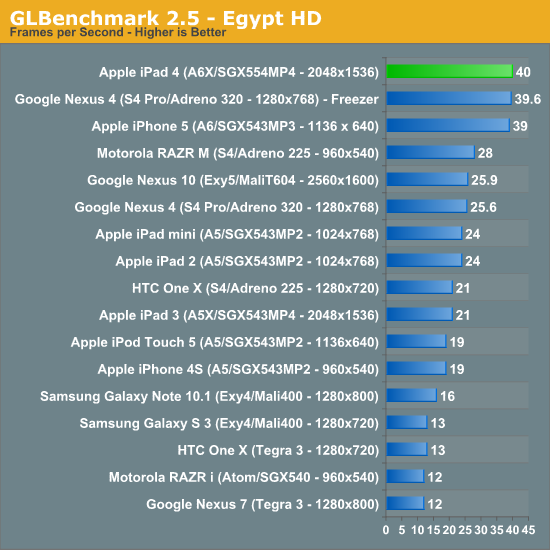
Despite sub-2x gains in a lot of the synthetic tests, Egypt HD shows us what's possible in a simulated game: the new iPad is roughly twice the speed of the previous gen model when running at the panel's native resolution. How we've seen this implemented in many cases is with titles finally running at native resolution on the iPad 4 vs. some lower, scaled resolution on the iPad 3.

The Egypt Classic test is a much lighter workload, as a result most of these devices hit 60 fps at their native resolution:
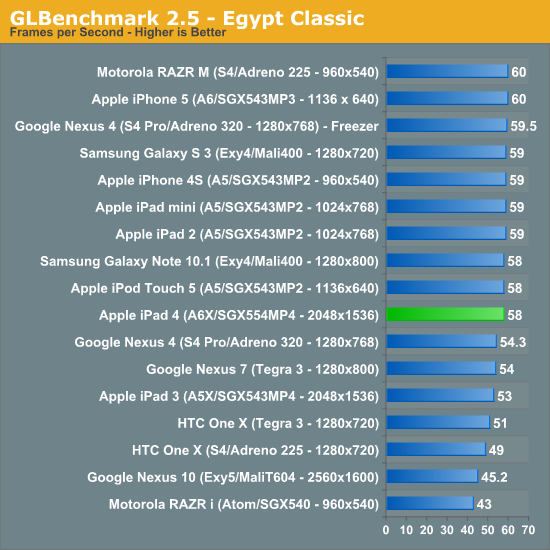
Although Egypt HD is a bit overkill for today's games, Classic undershoots by a good amount. The offscreen test however does provide some guidance as to whether or not these devices would be able to hit 30 fps on an appreciably heavier workload:
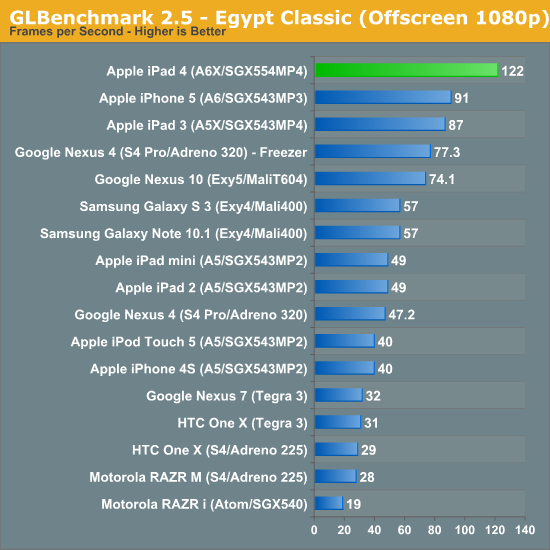










113 Comments
View All Comments
darkcrayon - Friday, December 7, 2012 - link
Ok that was pretty funny. "When you need paper that gets stuff done".Most documents in existence electronically are closer to a 3:4 aspect ratio. I'm sorry, but it's true. And they will fit an iPad sized screen more conveniently. But please, feel free to show me the treasure trove of ready made documents that are 9:16 or even 10:16 long.
Also, show me the benchmarks where the Nexus 10 GPU is better than the iPad 3 - not that that disproved my point. The one in the iPad 4 is quite a bit more powerful, so it's a legitimate area where the Nexus 10 is *not* a "much better tablet". And of course don't even get us started on 10" Android tablet apps.
ltcommanderdata - Thursday, December 6, 2012 - link
Any estimate on the SGX554MP4 clock speed? Since the 16% pixel fill performance difference is supposed to be largely clock speed related and the iPad 3's SGX543MP4 was clocked at 250MHz, that works out to 290MHz. Previous Apple SoC used a 4x multiplier between CPU and GPU. If the A6X changed to a 5x multiplier, then a 1.4GHz CPU works out to a 280MHz GPU, which seems to match what is being seen here.And process improvements for SoC power and thermals don't have to wait for 20 nm. Samsung has a 28 nm process, which they claim uses the same design rules as their 32nm process allowing a quick and easy transition, while offering power or performance benefits over their 32 nm process. I'm guessing 2013 iDevices will use a combination of shrinks and new SoC on the 28 nm Samsung process, which with all the TSMC rumours, may be the last SoC Apple makes with Samsung. 2014 iDevices would then use TSMC 20 nm.
Krysto - Thursday, December 6, 2012 - link
So it seems that in terms of gaming performance (which is really what matters when you evaluate a GPU), the devices compare as it follows:Ipad 4, Nexus 4 and iPhone 5 have the same performance in games - compared as devices, running at their own native resolution.
http://images.anandtech.com/graphs/graph6472/51760...
As for the GPU's themselves, it seems the A6X GPU is 42% faster than Mali T604, while Mali T604 and Adreno 320 are about 10-20% faster than the A6 GPU (iPhone 5), and than the A5X GPU (iPad 3)
http://images.anandtech.com/graphs/graph6472/51761...
coder543 - Thursday, December 6, 2012 - link
from one perspective. Honestly, benchmarks are just benchmarks. I'd agree with that assessment as far as these benchmarks go though. I'm not sure how much it matters -- suffice it to say they're all very fast.Alucard291 - Sunday, December 9, 2012 - link
Very slow surely? As this is STILL about 10 years behind desktop gpu'sltcommanderdata - Thursday, December 6, 2012 - link
Well the Nexus 4 having the same gaming performance as the iPad 4 and iPhone 5 depends on how often people take their phone into a freezer to play games.michal1980 - Thursday, December 6, 2012 - link
amazing. Apple must be paying for this coverage, and it was a week or two ago I was told that something was coming soon.should have figured, another sligthly updated apple product
darkcrayon - Thursday, December 6, 2012 - link
Just as we should've figured you'd be in the comment section whining about it ;)vision33r - Thursday, December 6, 2012 - link
Why would Apple be interested in marketing to PC enthusiasts on a site like this? It's a waste of money if they did pay Anand.In case you ever opened a male or female fashion mag or financial magazine, Apple advertisements are everywhere. Clearly they are more interested in marketing towards rich casual computer users.
So your theory of Apple paying for this coverage as usual trolling and Apple hating. That's ok, they don't mind you hating them on a website they have little interested marketing on.
pliablemoosethebanned - Thursday, December 6, 2012 - link
Yep, Anand needs to focus more on crap products like the Surface tablet.